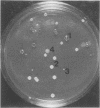Abstract
The conditions for isolation and cultivation of Propionibacterium acnes and related propionibacteria were studied in detail. Triton X-100 added to the diluent inhibited the growth of propionibacteria in concentrations of 0.05 to 0.1%. However, such was not the case with Tween 80; rather, growth of the bacteria was further enhanced by this agent. Consequently, Tween 80 was considered to be a suitable surfactant for addition to the diluent for isolation of propionibacteria. A new medium for isolating propionibacteria from human skin was developed. Comparative studies with colonies of P. acnes, Propionibacterium granulosum, and Staphylococcus epidermidis showed morphological differences among the colonies; thus, the medium was very useful for differentiating and identifying species of the microbes. The new medium was used for studies on the distribution of propionibacteria on the foreheads of 30 Japanese volunteers. Among 447 strains of P. acnes and 86 strains of P. granulosum isolated from the volunteers, all strains of the former were positive for indole, nitrate, milk, and gelatin hydrolysis, whereas all strains of the latter were negative for all of the tests.
Full text
PDF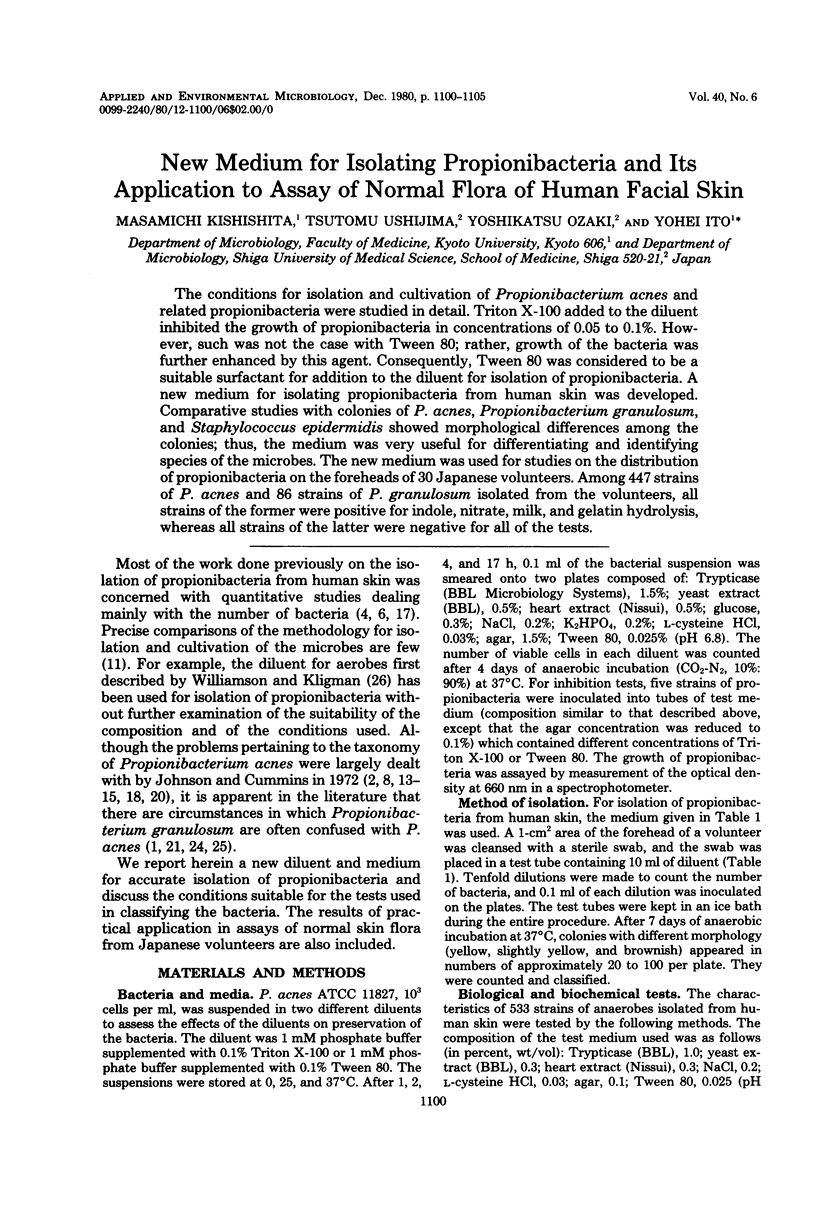
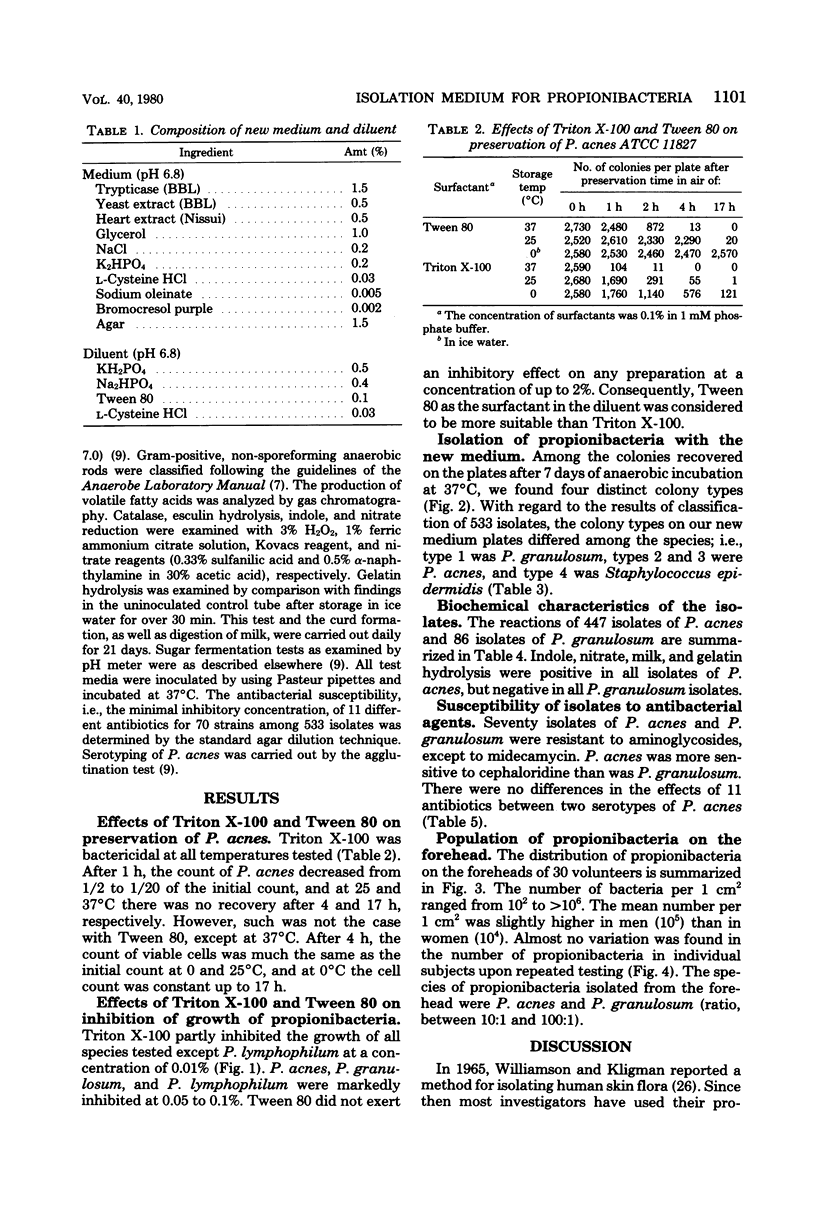
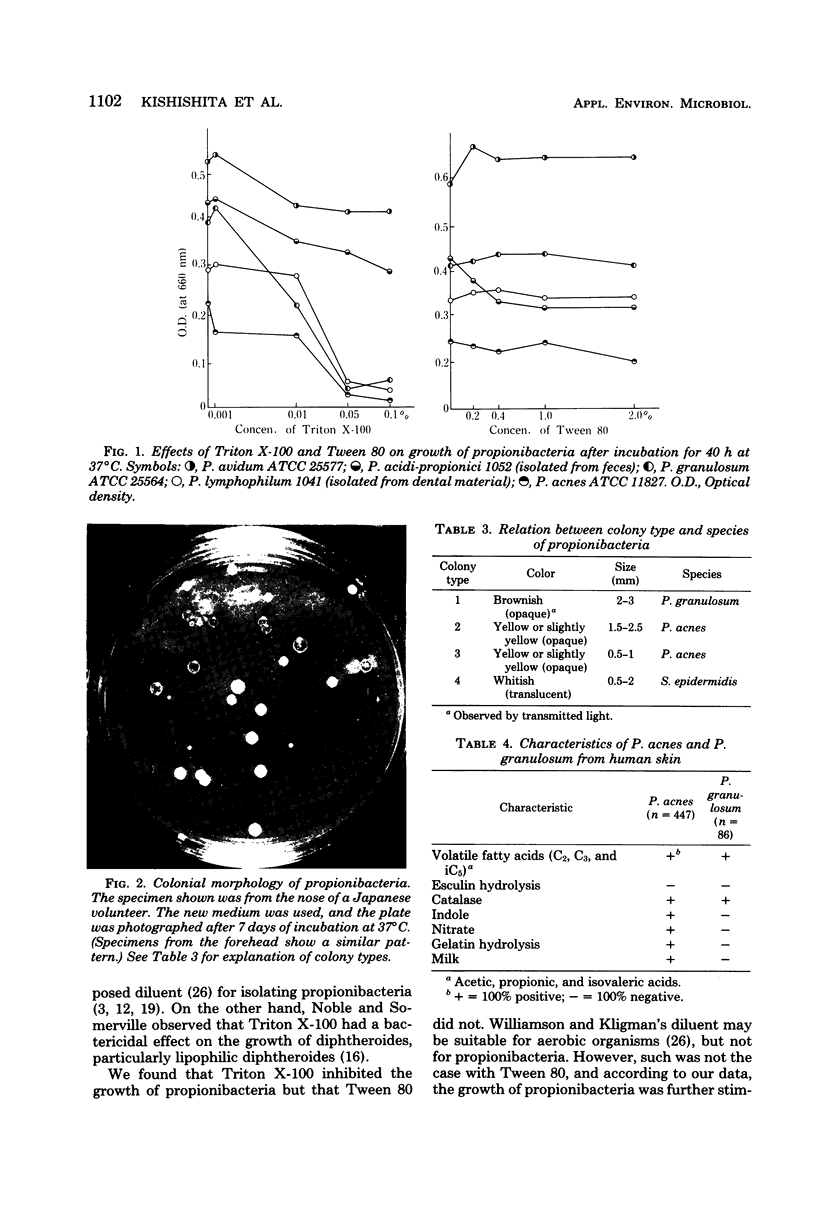
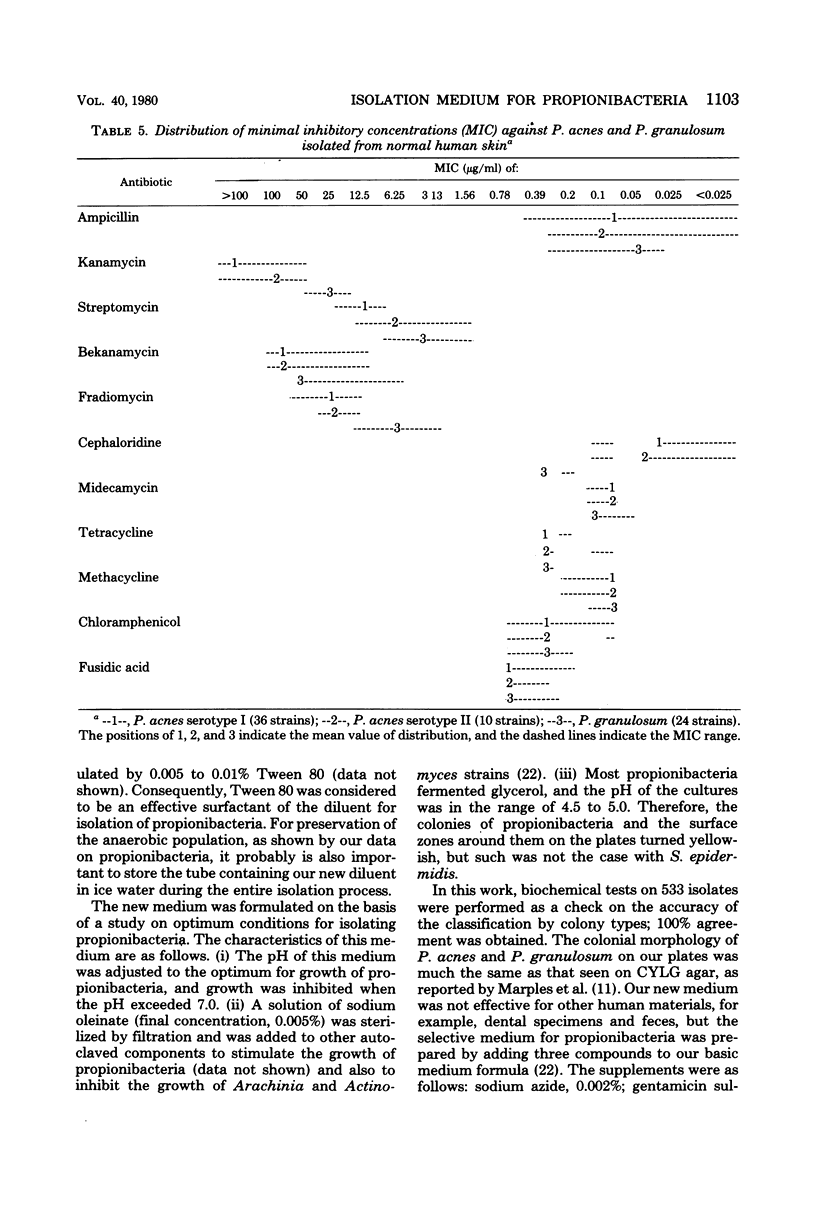
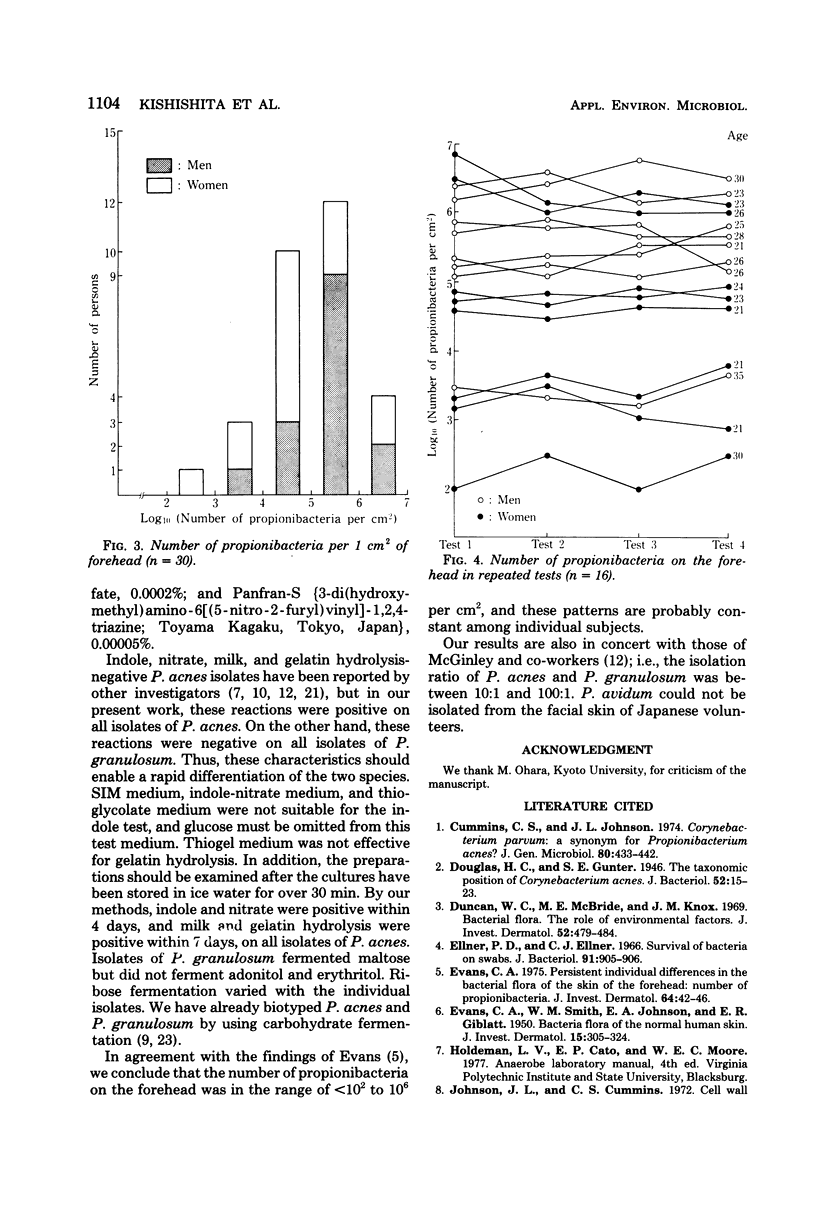
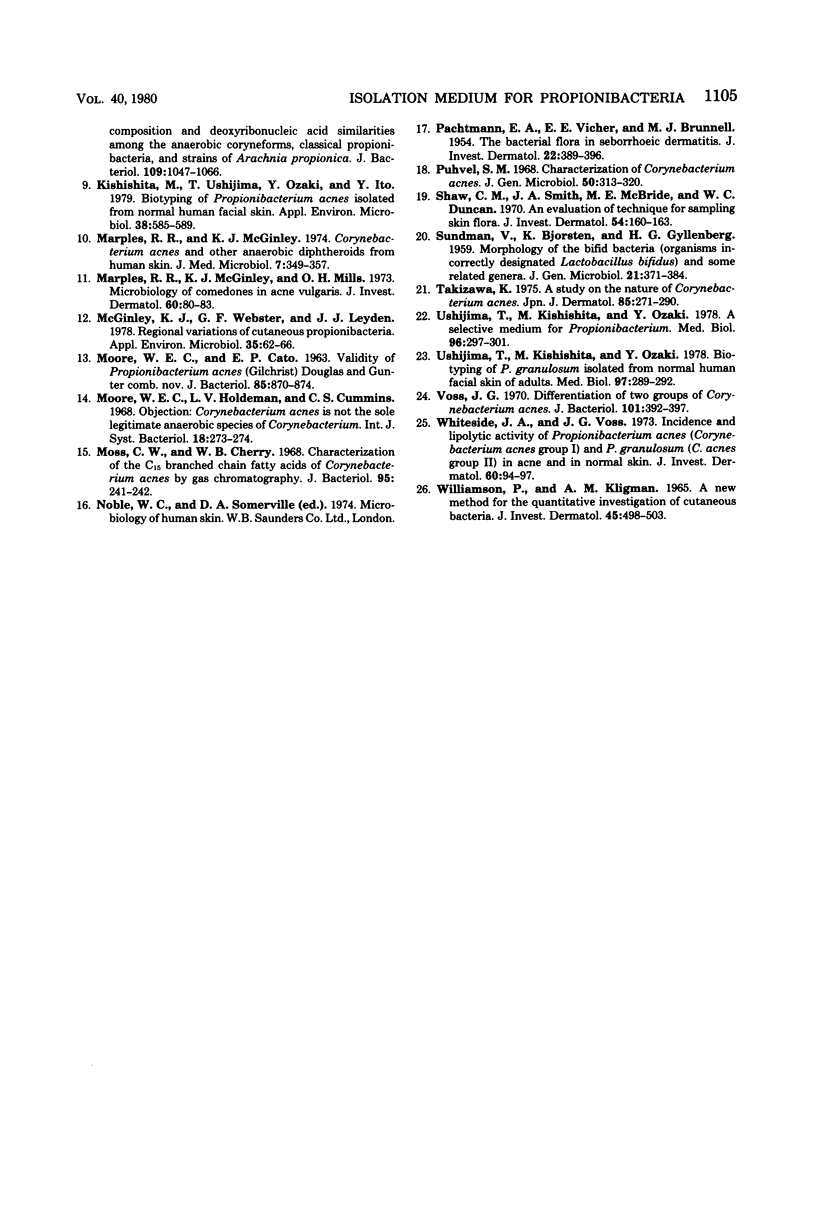
Images in this article
Selected References
These references are in PubMed. This may not be the complete list of references from this article.
- Cummins C. S., Johnson J. L. Corynebacterium parvum: a synonym for Propionibacterium acnes? J Gen Microbiol. 1974 Feb;80(2):433–442. doi: 10.1099/00221287-80-2-433. [DOI] [PubMed] [Google Scholar]
- Douglas H. C., Gunter S. E. The Taxonomic Position of Corynebacterium acnes. J Bacteriol. 1946 Jul;52(1):15–23. [PMC free article] [PubMed] [Google Scholar]
- Duncan W. C., McBride M. E., Knox J. M. Bacterial flora. The role of environmental factors. J Invest Dermatol. 1969 May;52(5):479–484. doi: 10.1038/jid.1969.81. [DOI] [PubMed] [Google Scholar]
- EVANS C. A., SMITH W. M., JOHNSTON E. A., GIBLETT E. R. Bacterial flora of the normal human skin. J Invest Dermatol. 1950 Oct;15(4):305–324. doi: 10.1038/jid.1950.105. [DOI] [PubMed] [Google Scholar]
- Ellner P. D., Ellner C. J. Survival of bacteria on swabs. J Bacteriol. 1966 Feb;91(2):905–906. doi: 10.1128/jb.91.2.905-906.1966. [DOI] [PMC free article] [PubMed] [Google Scholar]
- Evans C. A. Persistent individual differences in the bacterial flora of the skin of the forehead: numbers of propionibacteria. J Invest Dermatol. 1975 Jan;64(1):42–46. doi: 10.1111/1523-1747.ep12540897. [DOI] [PubMed] [Google Scholar]
- Johnson J. L., Cummins C. S. Cell wall composition and deoxyribonucleic acid similarities among the anaerobic coryneforms, classical propionibacteria, and strains of Arachnia propionica. J Bacteriol. 1972 Mar;109(3):1047–1066. doi: 10.1128/jb.109.3.1047-1066.1972. [DOI] [PMC free article] [PubMed] [Google Scholar]
- Kishishita M., Ushijima T., Ozaki Y., Ito Y. Biotyping of Propionibacterium acnes isolated from normal human facial skin. Appl Environ Microbiol. 1979 Oct;38(4):585–589. doi: 10.1128/aem.38.4.585-589.1979. [DOI] [PMC free article] [PubMed] [Google Scholar]
- MOORE W. E., CATO E. P. VALIDITY OF PROPIONIBACTERIUM ACNES (GILCHRIST) DOUGLAS AND GUNTER COMB. NOV. J Bacteriol. 1963 Apr;85:870–874. doi: 10.1128/jb.85.4.870-874.1963. [DOI] [PMC free article] [PubMed] [Google Scholar]
- Marples R. R., McGinley K. J. Corynebacterium acnes and other anaerobic diphtheroids from human skin. J Med Microbiol. 1974 Aug;7(3):349–357. doi: 10.1099/00222615-7-3-349. [DOI] [PubMed] [Google Scholar]
- Marples R. R., McGinley K. J., Mills O. H. Microbiology of comedones in acne vulgaris. J Invest Dermatol. 1973 Feb;60(2):80–83. doi: 10.1111/1523-1747.ep12724149. [DOI] [PubMed] [Google Scholar]
- McGinley K. J., Webster G. F., Leyden J. J. Regional variations of cutaneous propionibacteria. Appl Environ Microbiol. 1978 Jan;35(1):62–66. doi: 10.1128/aem.35.1.62-66.1978. [DOI] [PMC free article] [PubMed] [Google Scholar]
- Moss C. W., Cherry W. B. Characterization of the C15 branched-chain fatty acids of Corynebacterium acnes by gas chromatography. J Bacteriol. 1968 Jan;95(1):241–242. doi: 10.1128/jb.95.1.241-242.1968. [DOI] [PMC free article] [PubMed] [Google Scholar]
- PACHTMAN E. A., VICHER E. E., BRUNNER M. J. The bacteriologic flora in seborrheic dermatitis. J Invest Dermatol. 1954 May;22(5):389–396. doi: 10.1038/jid.1954.55. [DOI] [PubMed] [Google Scholar]
- Puhvel S. M. Characterization of Corynebacterium acnes. J Gen Microbiol. 1968 Feb;50(2):313–320. doi: 10.1099/00221287-50-2-313. [DOI] [PubMed] [Google Scholar]
- SUNDMAN V., af BJORKSTEN, GYLLENBERG H. G. Morphology of the bifid bacteria (organisms previously incorrectly designated Lactobacillus bifidus) and some related genera. J Gen Microbiol. 1959 Oct;21:371–384. doi: 10.1099/00221287-21-2-371. [DOI] [PubMed] [Google Scholar]
- Shaw C. M., Smith J. A., McBride M. E., Duncan W. C. An evaluation of techniques for sampling skin flora. J Invest Dermatol. 1970 Feb;54(2):160–163. doi: 10.1111/1523-1747.ep12257936. [DOI] [PubMed] [Google Scholar]
- Takizawa K. [A study on the nature of Corynebacterium acnes (author's transl)]. Nihon Hifuka Gakkai Zasshi. 1975 Apr 15;85(5):271–290. [PubMed] [Google Scholar]
- Voss J. G. Differentiation of two groups of Corynebacterium acnes. J Bacteriol. 1970 Feb;101(2):392–397. doi: 10.1128/jb.101.2.392-397.1970. [DOI] [PMC free article] [PubMed] [Google Scholar]
- Whiteside J. A., Voss J. G. Incidence and lipolytic activity of Propionibacterium acnes (Corynebacterium acnes group I) and P. granulosum (C. acnes group II) in acne and in normal skin. J Invest Dermatol. 1973 Feb;60(2):94–97. doi: 10.1111/1523-1747.ep12724177. [DOI] [PubMed] [Google Scholar]
- Williamson P., Kligman A. M. A new method for the quantitative investigation of cutaneous bacteria. J Invest Dermatol. 1965 Dec;45(6):498–503. doi: 10.1038/jid.1965.164. [DOI] [PubMed] [Google Scholar]



